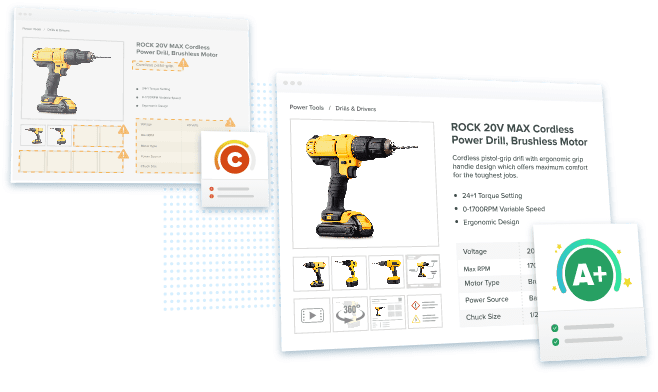Amazon A9 Algorithm Ranking Tips and Best Practices for Manufacturers

- Amazon's A9 algorithm is essential for product visibility in the marketplace.
- Manufacturers can leverage the algorithm by optimizing product listings, enhancing relevance, sales performance, and customer satisfaction, and complying with platform policies.
- Success on Amazon requires ongoing effort and adapting to changes while working within guidelines.
In this Article
Amazon is a giant of e-commerce. The marketplace has a global reach and connects buyers and sellers from more than 130 countries. However, navigating the vast landscape of the Amazon Marketplace can be challenging. While the sheer volume of sales on the platform is undeniable (37.6% of the US e-commerce market in 2023!), achieving visibility and driving sales requires a strategic approach.
One crucial factor in this equation is Amazon’s A9 algorithm, the powerful force that determines which products appear first in search results. Manufacturers who understand how this algorithm works and leverage it to their advantage will see their revenue boats rise with Amazon’s rising tide of sales volume.
This knowledge is essential because the A9 algorithm is constantly learning and changing. Therefore, manufacturers must regularly update their Amazon search engine optimization (SEO) practices and optimize their product listings. This article will provide practical tips for manufacturers to navigate the A9 algorithm effectively, but first, let’s understand how it works.

Understanding Amazon A9 Algorithm
What is Amazon's A9 algorithm?
The A9 algorithm is the brain of the Amazon marketplace search engine. It figures out which products best match your searches. This sophisticated technology is a digital matchmaker, connecting potential buyers with the most relevant products among millions of listings.
One might ask, where did Amazon get this name, A9? To answer this question, one must first understand the history of search on Amazon. Initially, Amazon didn’t have an in-house search engine, so it subcontracted the responsibility to a small company called A9.com. A9.com was established in 2003 as an Amazon subsidiary to develop search and advertising technology. A9 introduced several innovative services, including “search inside the book,” BlockView for street-level imagery, and OpenSearch for plug-in search sources. Seeing how critical this company’s products were to the success of Amazon.com, the e-commerce giant integrated A9’s functions into its primary operations, redirecting A9.com to Amazon’s homepage.
How does this Amazon algorithm work?
Picture this: you’re a power tools manufacturer and have designed a new drill press. The tool is a game-changer, but how do you ensure that machine shops and DIY enthusiasts searching for “heavy-duty drill press” on Amazon discover your creation?
The A9 algorithm is like the conductor of an online orchestra, constantly working to connect searching customers with the most relevant products. This amazon a9 algorithm is the system that analyzes various “clues” within a product listing and the customer’s search query. In other words, A9 doesn’t magically guess what a customer wants. Instead, it relies on the “clues” to match the right product to the customer’s search.
These clues can include:
- Keywords: The algorithm pays close attention to the words/terms used in your product title, description, features, and bullet points. So, if the customer searches for “heavy-duty drill press,” the algorithm will prioritize this particular term and look for it in your listing.
- Sales performance: The algorithm favors products with a history of strong sales velocity and high conversion rates (meaning customers who view the listing actually buy it). So, the more workshops add your drill press to their cart after seeing your listing, the better your ranking might become.
- Customer satisfaction: Amazon operates the marketplace in a way that rewards sellers with whom the most customers are happy. This is crucial because the customers are the reason the marketplace exists in the first place. In this regard, the algorithm considers positive reviews and ratings as a strong signal that your products are reliable and effective.
- The overall package: The algorithm doesn’t judge a product by its pictures alone. It considers everything from clear and concise product information to competitive pricing.
Insights from these clues allow the algorithm to rank your product listing. The higher the ranking, the more likely your drill press will appear on the first page of search results, significantly increasing its visibility to potential customers.

Critical Areas for Manufacturers to Focus On When Working with A9
Most manufacturers adopt a particular strategy after long hours of consulting and evaluating. So, the decision to sell on Amazon is informed by the expectation that the platform will open new avenues for additional revenue. As we’ve seen, part of optimizing the revenue potential of the Amazon Marketplace is understanding how the brain of the platform’s search technology works.
However, understanding how the a9 algorithm works is only part of the job. The other half involves optimizing your product listings to align with the search engine’s best practices. This section highlights crucial tactics manufacturers can use to leverage Amazon’s A9 algorithm for better sales history figures.
1. SEO Optimizing product listings
Optimizing product listings is another way of saying that you must make it easy for the A9 algorithm to index your products. This allows the algorithm to remember to show your listings when a buyer uses specific terms when searching the marketplace. Some specific techniques you can implement include:
Crafting effective titles
The product title is one of the most critical elements of your Amazon listing. It is the first thing potential buyers see, significantly impacting your product’s visibility in search results based on keyword research.
You attract the algorithm’s attention by including primary keywords at the beginning of your title. This helps the A9 algorithm understand what your product is about, thereby improving its ranking for relevant searches. For example, a title like “Heavy-Duty Drill Press – 16-Speed, 1HP Motor, Adjustable Table” clearly conveys essential information and includes relevant keywords.
However, while it is vital to be descriptive, avoid overloading the title with unnecessary details. A clear, concise title is easier to read and more likely to catch the eye of the algorithm’s crawlers. So, highlight key features such as brand, product type, size, color, and specifications without making the title overly long.
Unfortunately, most manufacturers may find this technique more demanding, especially when dealing with a vast product catalog. The challenge deepens if the product details are scattered across several spreadsheets stored in different locations. You’d need to hire quite a substantial number of people to do this work properly.
On the positive side, there are tools designed to relieve vendors of such stress. For example, a product information management (PIM) solution consolidates the product details into a neatly organized database. This ensures merchants can manage and organize product information efficiently. All the necessary details are available to create compelling product titles. Also, PIM software allows you to enforce standards so that all product titles you create have an equal appeal. It also allows for easy updating and optimization of titles to keep them relevant and effective.
Writing compelling product descriptions
Moving beyond the title, you can create a selling point for your product by writing compelling product descriptions. While the A9 algorithm considers this content, it’s primarily for convincing customers to make a purchase. So, the description should use clear, benefit-focused language, breaking information into easily digestible bullet points.
For instance, when describing your drill press, you might highlight its precision, durability, and versatility: “Achieve pinpoint accuracy with our 12-speed drill press, designed for both delicate woodworking and heavy-duty metalwork. The cast iron table ensures stability, while the LED work light illuminates your project for enhanced visibility.”
Again, a PIM solution like Catsy PIM can be invaluable here. It enriches otherwise basic details into high-quality product information, allowing you to create a comprehensive description like the one above.
Utilizing backend search terms
Backend search terms are like hidden keywords that the A9 algorithm uses to categorize your product. While not directly visible to customers, they play a vital role in the algorithm’s understanding. Amazon allows you to include a set of backend search terms where you can add even more relevant keywords that describe your product’s functionalities and specifications.
Use this space to include additional relevant keywords that didn’t fit naturally into your title or description. This can help your product appear in more search results. However, avoid redundancies by not repeating keywords already in your title or description. Instead, include variations, synonyms, and related terms. Ensure you adhere to Amazon’s guidelines for backend search terms, such as character limits and prohibited terms. Proper use of these terms can boost your product’s visibility without compromising the quality of your listing.
Using high-quality images
Images are a vital component of your Amazon listing. While they don’t directly impact text-based search algorithms, they significantly influence click-through rates and conversion rates, which in turn affect your product’s higher ranking.
For instance, you can showcase your product from multiple angles, including lifestyle photos and perhaps an infographic highlighting its key features and dimensions. While at it, ensure the main image has a pure white background, per Amazon’s requirements, and aim for high-resolution pictures of at least 1000 pixels on the longest side.
As you can see, this creates a burden regarding the hours required to get everything right when dealing with many products. This is the reality of most manufacturers. So, how do you ensure you stay within Amazon’s requirements regarding images for each item in your vast catalog, including variants?
The solution lies in a digital asset management (DAM) solution. Like PIM for manufacturers, DAM software helps you manage, organize, and optimize your digital assets. For instance, a DAM can ensure all your product images meet Amazon’s specifications, such as the 1000-pixel minimum size and the white background requirement for main images. You set the rule once, and users must adhere to it when preparing images for Amazon’s Marketplace.
Moreover, a solution like Catsy’s DAM offers features such as batch editing and resizing images. This means you can quickly optimize a whole set of a product’s photos for Amazon’s requirements, saving time and ensuring consistency across your product line.

2. Enhancing relevance in Product Listings with strategic keywords
We learned earlier that the A9 algorithm relies on certain clues to decide which product listings to show in searches. These clues have one primary objective: to provide the closest match to a buyer’s search terms.
So, after optimizing your product listings, the next crucial step in navigating the algorithm is enhancing product relevance. As you can imagine, this process involves strategic keyword usage. Other techniques you can deploy include precise category selection and leveraging Amazon’s unique browse node structure.
Keyword research and implementation
We’ve already touched on the importance of keywords. Now, let’s dig into more detail. Keyword research involves identifying the terms potential customers use to search for specific products. Tools like Amazon Vendor Central or Google Keyword Planner can help you discover relevant keywords with high search volume and low competition.
Once you have a list of relevant keywords, strategically integrate them throughout your product listing. For instance, you can incorporate them into product titles, descriptions, features, and backend search terms. PIM software can be a handy tool for this task.
Nonetheless, do not overuse keywords unnaturally (keyword stuffing) because it can undermine your products’ ranking. Instead, aim for a balance, ensuring the descriptions are informative and user-friendly while incorporating relevant keywords.
Category and subcategory selection
This is an often overlooked but crucial aspect of product relevance. Amazon’s category structure is designed to help customers find what they’re looking for. As such, placing your product in the most appropriate category and subcategory ensures it appears in the right search results and browse pages.
For example, a manufacturer selling a drill press might be tempted to list it under a broad category like “Power Tools.” However, a more specific subcategory like “Drill Presses” under “Power Tools” would be more appropriate. This precise categorization helps the A9 algorithm precisely understand your product and show it to the most relevant audience.
Leveraging Amazon's browse node structure
Browse nodes are like the branches of Amazon’s category tree, each with a unique numerical identifier. Understanding and utilizing these nodes can help optimize your product’s placement within Amazon’s hierarchy.
For example, a manufacturer’s drill press might be included in the browse node “Power & Hand Tools > Power Tools > Drill Presses.” By including this browse node information in your product data, you’re giving the algorithm additional context about your product, which can improve its visibility in both search results and category browsing.
Moreover, browse nodes can be particularly useful for niche products. Suppose you’ve developed a specialized drill press for jewelry making. In that case, you might be able to list it under both “Power Tools” and “Jewelry Making Supplies” browse nodes, expanding your potential customer base.

3. Boosting sales conversions with improved ranking & product visibility
Sales performance is vital in informing the A9 algorithm about ranking products in the Amazon marketplace. Products that sell more are more visible to the algorithm, so boosting sales performance is essential. Some tactics to help achieve this goal include pricing strategies, inventory management, and fulfillment methods.
Pricing strategies
Price is a significant factor influencing customer purchasing decisions. However, A9 also considers pricing when ranking products. While the cheapest option might not always win, manufacturers should know price elasticity and its impact on search results.
Price elasticity refers to how sensitive customer demand is to price changes. For example, a slight price decrease might significantly increase your sales for a commodity drill press. Conversely, a high-end, professional-grade drill press might have a more inelastic demand, meaning a small price change won’t significantly impact sales.
Another effective pricing strategy is to offer temporary discounts or create bundle deals. For example, you might package your drill press with complementary items like drill bits or safety gear. This can increase the perceived value of your items, potentially boosting both organic sales and your product’s ranking in search results.
Inventory management
Amazon marketplace’s search engine favors products that are in stock and ready to ship. Why? Out-of-stock items lead to poor customer experiences, something Amazon strives to avoid.
To optimize your inventory management, consider using forecasting tools to predict demand and adjust your stock levels accordingly. You do not always have to rely on sophisticated tools, while PIM software integrates with inventory management systems. For example, Catsy’s PIM takes product details from the inventory management system, including inventory levels. The solution enriches this data and pushes it to Amazon Vendor Central through built-in connectors. The integration ensures that any changes in the inventory management system are reflected automatically in the merchant’s Amazon accounts.
Fulfillment methods
The way you fulfill orders can significantly influence your product’s ranking. Amazon prefers products fulfilled through its services, particularly Fulfillment by Amazon (FBA).
When you use FBA, Amazon handles storage, packing, and shipping. This ensures fast, reliable delivery (often with Prime shipping) and gives Amazon more control over the customer experience. As a result, FBA products usually receive a boost in search rankings.
However, FBA isn’t always the best option for every product. The storage fees might be prohibitive for large, heavy items like a drill press. In such cases, Seller Fulfilled Prime (SFP) could be a good alternative. With SFP, you store and ship products yourself but commit to meeting Prime shipping standards. While it requires more work on your part, SFP can still provide some of the ranking benefits associated with Prime eligibility.
If neither FBA nor SFP is feasible, focus on maintaining high standards with your own fulfillment process. Quick shipping, accurate tracking information, and prompt customer service can help improve your vendor metrics, which in turn can positively influence your product’s ranking.

4. Improving customer satisfaction
As we’ve seen, the A9 algorithm prioritizes products that resonate with customers. Positive customer satisfaction is a crucial indicator for the algorithm, and manufacturers who prioritize happy customers will be rewarded with better rankings.
How can you make your customers happy?
Encourage and manage customer reviews.
Positive reviews are like gold on the Amazon marketplace. They provide social proof, help potential buyers make informed decisions, and significantly influence the A9 algorithm’s ranking choices. As such, encouraging and managing customer reviews should be a top priority for manufacturers.
To encourage reviews, consider including a card with your product that politely asks customers to share their experience on Amazon. You might also follow up via email (within Amazon’s guidelines) after a purchase, asking if the customer is satisfied and gently reminding them to leave a review. Remember, Amazon prohibits incentivizing reviews, so focus on providing an excellent product and customer experience.
Managing reviews involves more than just collecting them. Regularly monitor product reviews and respond to them, especially negative ones. For example, if a customer complains about a faulty part in your drill press, respond publicly with empathy and a solution. This shows potential buyers that you’re attentive and committed to customer satisfaction. Moreover, the A9 algorithm takes note of seller responsiveness, which can positively impact your product ranking.
Handle returns and customer service efficiently.
Even with the best products, returns can happen. Make the return process for your drill press clear, convenient, and hassle-free. A smooth return experience can leave a positive impression, even on an unhappy customer.
Amazon has strict performance metrics for sellers, including return rate and customer service response time. Meeting or exceeding these standards keeps your account in good standing and contributes to better product rankings.

5. Staying compliant with Amazon's policies
The A9 algorithm is robust, but it’s important to remember that Amazon has established vendor rules and guidelines. Operating within these guidelines is essential for maintaining a healthy vendor account and avoiding potential ranking penalties.
How can manufacturers ensure compliance?
Understand Amazon's rules and guidelines.
This is the foundation of compliance. Amazon has policies covering everything from product listings to customer interaction. As a manufacturer selling on the platform, you must familiarize yourself with policies relevant to your product category.
Avoid common pitfalls that can hurt rankings.
Specific actions can negatively impact your ranking or even lead to account suspension. Some examples include:
- Black hat SEO tactics: A9 prioritizes organic product discovery. So, avoid black-hat Amazon SEO strategies like keyword stuffing, misleading product information, or inauthentic reviews, as these tactics can backfire.
- Copyright or trademark infringement: Selling products that infringe on intellectual property rights is strictly prohibited. Ensure you have permission to sell any trademarked or copyrighted elements associated with your products.
- Late shipments and high cancellation rates: A9 favors sellers who deliver products on time and maintain a low order cancellation rate. To avoid these issues, prioritize efficient fulfillment and clear communication.
Keep up with policy changes.
This is perhaps the most challenging aspect of compliance, but it’s essential. Amazon regularly updates its policies in response to market trends, legal requirements, and customer feedback. What was permissible yesterday might not be today.
To stay informed, regularly check Amazon’s vendor central announcements and policy update pages. Consider setting up alerts or dedicating time each week to reviewing any changes.
You can also participate in seller/vendor forums and industry groups. Other vendors often share information about policy changes and their implications, providing valuable insights and interpretations.
When a policy change occurs, proactively update your listings and practices to ensure compliance. Remember, the A9 algorithm favors sellers who consistently adhere to Amazon’s policies. By maintaining compliance, you’re not just avoiding penalties but also positioning your products for better visibility and success on the platform.
Conclusion
Amazon is an invaluable platform for manufacturers looking to extend their reach and grow revenue. To make the most of the marketplace, brands must prioritize understanding the A9 algorithm and optimizing their products.
However, it’s crucial to remember that no shortcuts exist to sustainable success on Amazon. While it might be tempting to seek quick wins through manipulative tactics, such approaches often backfire, risking your product’s ranking and entire presence on the platform.
Instead, manufacturers should focus on long-term strategies, prioritizing product quality, customer satisfaction, and adherence to Amazon’s policies. Doing so, you work harmoniously with the A9 algorithm and build a robust and resilient brand presence on the Amazon Marketplace that can withstand market changes and competition.
Amazon Vendor Central is a web-based platform that allows vendors to sell their products directly to Amazon. Through Vendor Central, vendors can manage their product inventory, monitor sales performance, and create marketing campaigns. This platform also allows vendors to track and analyze customer data, set prices and promotional pricing, and receive payments from Amazon.
adapt?
Amazon updates its A9 algorithm regularly to enhance user experience and ensure search results remain relevant. These updates can impact how products are ranked and displayed in search results. Vendors should stay informed about algorithm changes through Amazon’s Vendor Central updates, blogs, and forums.
Optimizing product listings involves several critical practices, including:
- Keyword optimization.
- Use clear, high-resolution images that showcase the product from multiple angles and in-use scenarios.
- Write detailed and persuasive product descriptions highlighting features, benefits, and unique selling points.
- Encourage cheerful customer reviews through excellent product quality, customer service, and proactive review solicitation.
Customer satisfaction is crucial in maintaining sales performance and improving Amazon’s product rankings. Positive customer experiences, reflected in reviews and vendor metrics, contribute to higher conversion rates and repeat purchases. Amazon’s algorithm considers factors like vendor feedback ratings, order defect rates, and late shipment rates when ranking products.
To avoid negative impacts on Amazon sales and rankings, sellers should steer clear of:
- Violating Amazon policies
- Misleading claims
- Poor customer service
- Neglecting SEO optimization
- Ignoring customer feedback




